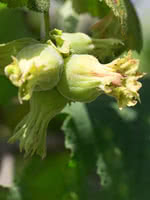Mon-Fri 9am - 5pm Mountain time
Common Hackberry vs Yamhill Hazelnut
Celtis occidentalis
Corylus avellana Yamhill
NOT AVAILABLE THIS SEASON - MIGHT RETURN
The Common Hackberry is a medium-sized deciduous tree that resembles the American Elm but is immune to Dutch Elm Disease. They are versatile and can adapt to a variety of growing conditions.
It produces purple-red, berry-like fruit with a large seed in the center. Both the sweet flesh, which tastes similar to dates, and the crunchy seed are edible. The fruit remains on the tree throughout the winter, offering a valuable food source for birds and other wildlife.
The Common Hackberry can also be a great addition to a pollinator garden. The tree itself is a host for the larvae of several butterfly species and the flowers provide a source of pollen and nectar.
The Yamhill Hazelnut is a tasty, relatively cold hardy hazelnut that is a popular European variety.
It is known to be a strong grower and has moderate eastern filbert blight resistance. It is a suitable pollinizer for the York Hazelnut and European Hazelnut.
Introduced by Oregon State University, The Yamhill Hazelnut is used by Ferror Roche for their candy and chocolate spread desserts.
Not all hazelnuts pollinate with each other so it is important to pick the correct pollination pairs. Two compatible varieties of hazelnut are required to produce nuts. Nuts will only be produced once maturity is reached, around 2-3 years.

